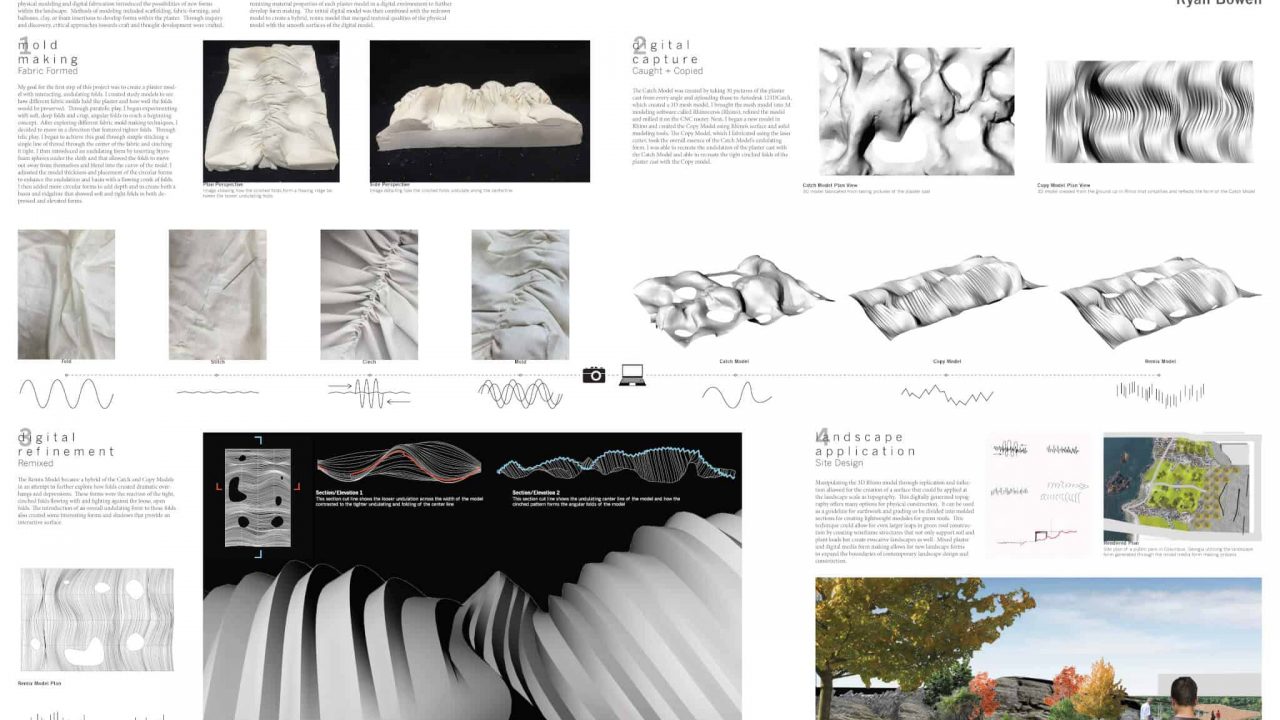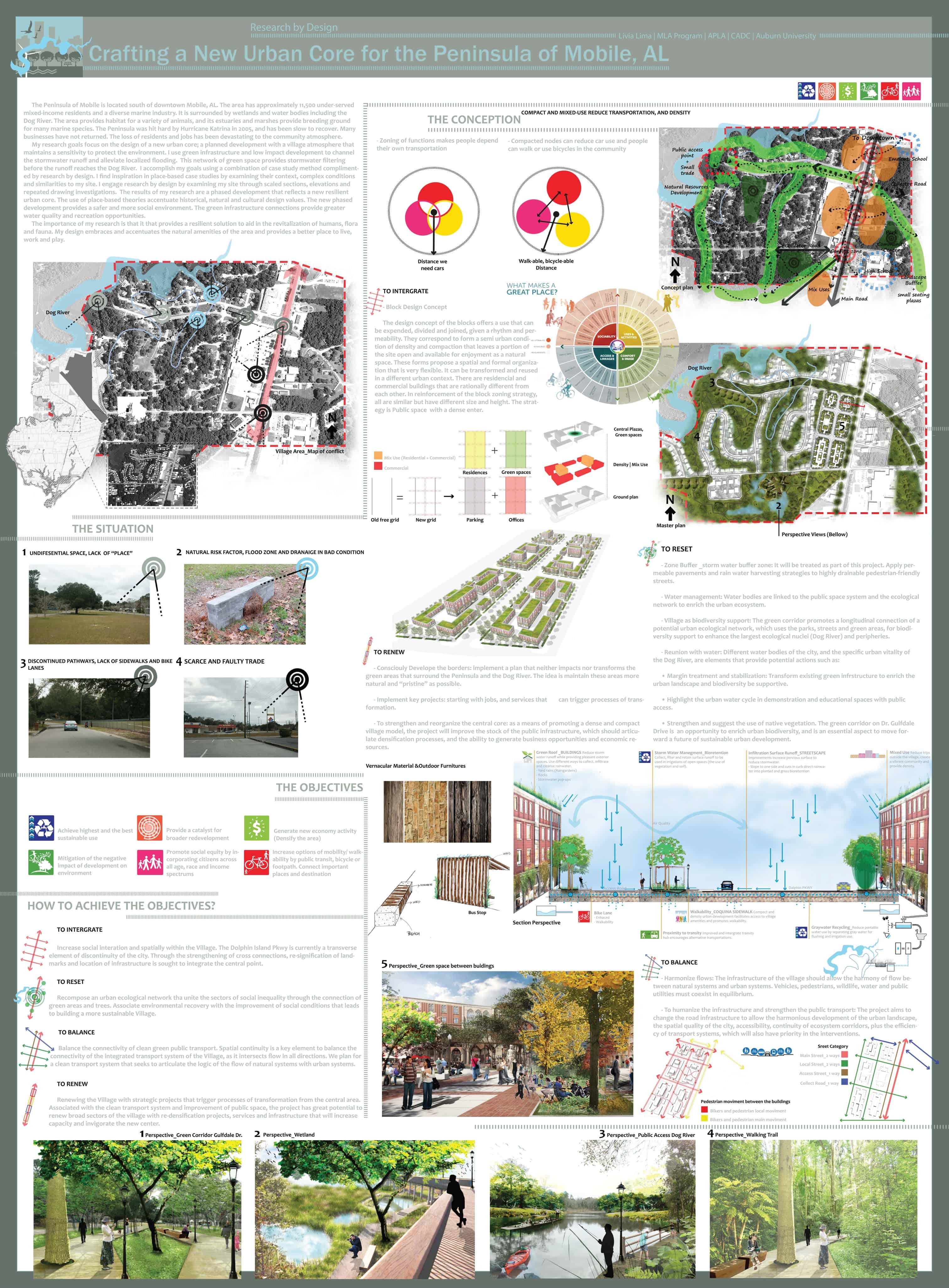APLA Students Win Awards at “This is Research: Student Symposium 2016”

The School of Architecture, Planning and Landscape Architecture was well represented among the award winners at the “This is Research: Student Symposium 2016,” held on April 13 at the Student Center. Out of the more than 400 undergraduate and graduate students who competed from Auburn and AUM, APLA students took home two first place awards and one second place in the Research and Creative Scholarship in Design, Arts and Humanities category. These awards included cash prizes.

Abigail Katsoulis and Madeline Gonzales, fifth-year architecture students, were first place winners for their oral presentation in the undergraduate Research and Creative Scholarship in Design, Arts and Humanities category for ARCHIBET: An A-Z Overview of Modern Architecture. Ryan Bowen, a dual Environmental Design/Master of Landscape Architecture student, won first place for his poster presentation in the undergraduate category for “Generation of new landscape forms through mold making, digital, and mixed media experimentation.” Livia Lima, a first–year MLA student, won second place in the graduate Creative Scholarship category for her oral presentation “Crafting a new urban core for the peninsula of Mobile, AL.”
 ARCHIBET was a semester-long project for Danielle Willkens’ History of Modern Architecture (ARCH 3120) in Spring 2015. Abigail Katsoulis and Madeline Gonzales, who were fourth year students at the time, were charged with making a dictionary of modern architecture that explained the key elements of “modern” design through an alphabetic system. Their alphabet could be composed of a mixture of people, places, projects, or ideas. They had to distill the exploration of modern architecture into twenty-six thoughtful “episodes,” using all letters effectively, that contained text images, citations, and list of additional resources for their readers. Developed and refined over the course of the semester, “The project was an exercise in research, synthesis, and thoughtful revision,” explains Willkens. “While committing the error of literally judging a book by its cover, it is clear that this team’s submission for the semester project, a dictionary of modern architecture, was professionally composed and executed.”
ARCHIBET was a semester-long project for Danielle Willkens’ History of Modern Architecture (ARCH 3120) in Spring 2015. Abigail Katsoulis and Madeline Gonzales, who were fourth year students at the time, were charged with making a dictionary of modern architecture that explained the key elements of “modern” design through an alphabetic system. Their alphabet could be composed of a mixture of people, places, projects, or ideas. They had to distill the exploration of modern architecture into twenty-six thoughtful “episodes,” using all letters effectively, that contained text images, citations, and list of additional resources for their readers. Developed and refined over the course of the semester, “The project was an exercise in research, synthesis, and thoughtful revision,” explains Willkens. “While committing the error of literally judging a book by its cover, it is clear that this team’s submission for the semester project, a dictionary of modern architecture, was professionally composed and executed.”
Ryan Bowen, a senior from Uriah, Alabama, presented a poster from his MLA Fall 2015 Studio research that was taught by Valerie Friedmann, visiting assistant professor in Landscape Architecture. He worked from the prompt “topograph,” studying plaster and then fabric molds to explore the terms “undulating and folding.” “In studio, Ryan rose to the challenge of experimenting with many different mediums—both physical and digital. It is a joy to see students take the time to reflect on their design process the way Ryan has in his This is Research poster,” says Friedmann. “Ryan’s willingness and ability to clearly document and articulate his goals, methods, and outcomes will serve him well as he continues to refine his own design process.” She encouraged him to enter his poster in the Student Symposium to showcase the sort of work CADC students do to other colleges. “It was good to see the breadth of research within our college as well as other schools,” says Bowen. “It was a privilege to represent CADC—and even better that I won!”
 Livia Lima’s poster “Crafting a New Urban Core for the Peninsula of Mobile, AL” was created in LAND 6330 Eco-Cultural PlaceMaking Studio: The Dauphin Island Peninsula in Mobile, AL taught by Charlene LeBleu, associate professor and MLA graduate program chair, and Elise Cormier, visiting assistant professor of Landscape Architecture. Lima’s research explored the creation of a new urban core for this area south of downtown Mobile that was badly damaged and slow to recover from Hurricane Katrina. She envisioned a planned development with a village atmosphere that maintains a sensitivity to protect the environment. “Livia has a unique way of expressing excitement in her drawings. People gravitate to her work. She did an excellent job exploring a “place-based” connection between the natural and man-made realms of the Dauphin Island Peninsula in Mobile, Alabama,” says LeBleu. “The essence of ‘place-based’ design drove almost every design move she undertook. She began work by immersing herself in the project’s setting—its culture, history, surrounding land forms, existing vegetation, and even the colors of the land, water and sky itself—in order to ‘tell the story’ through her design.”
Livia Lima’s poster “Crafting a New Urban Core for the Peninsula of Mobile, AL” was created in LAND 6330 Eco-Cultural PlaceMaking Studio: The Dauphin Island Peninsula in Mobile, AL taught by Charlene LeBleu, associate professor and MLA graduate program chair, and Elise Cormier, visiting assistant professor of Landscape Architecture. Lima’s research explored the creation of a new urban core for this area south of downtown Mobile that was badly damaged and slow to recover from Hurricane Katrina. She envisioned a planned development with a village atmosphere that maintains a sensitivity to protect the environment. “Livia has a unique way of expressing excitement in her drawings. People gravitate to her work. She did an excellent job exploring a “place-based” connection between the natural and man-made realms of the Dauphin Island Peninsula in Mobile, Alabama,” says LeBleu. “The essence of ‘place-based’ design drove almost every design move she undertook. She began work by immersing herself in the project’s setting—its culture, history, surrounding land forms, existing vegetation, and even the colors of the land, water and sky itself—in order to ‘tell the story’ through her design.”
Lima, who is from Cuiaba, Mato Grosso, Brazil, chose to study at Auburn because of its outstanding reputation and tradition, especially in regard to arts and applied science, and the MLA program caught her attention for its value, content and credibility on the labor market. “All the characteristics of the program are designed to teach students on how to plan constructions that attend to the contemporary needs of the world such as global growth, climate change, energy and water demand, urbanization, suburbanization, resource depletion, and others, while conserving a health environment,” says Lima. “Coming from a background of intensive environmental degradation and poor planning in the Midwest of Brazil, I strongly feel that program has a key role to help conserve and preserve the environment while supporting the building a new future, thus the choice for this excellent program at Auburn University.”
As Karen Rogers, Associate Dean for Graduate Studies and Research, sums up, “The award-winning work of these APLA students is stunning. It is characterized by combining visionary qualities with pragmatism: the students are innovative thinkers with the practical research and design skills to be able to make their bold ideas a reality. To be able to see the students present their work in person is privilege: they articulate, passionate and compelling. Congratulations!”
See more in:
Research,
Student Accolades,
Student Work
Related people:
Karen Rogers